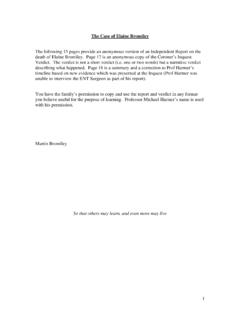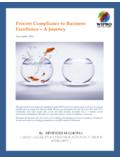Transcription of Contents
1 [Pre-publication copy] implementing human factors in healthcare How to guide - volume 2 Taking further steps Prepared by Dr Jane Carthey on behalf of the Clinical human factors Group (CHFG)This How to guide was commissioned by the Clinical human factors Group and supported by funding from The Health FoundationAcknowledgementAlthough Dr Carthey is the principal author of this How to guide it is important to acknowledge the collective effort and teamwork that contributed to its production. healthcare teams, human factors researchers and consultancy firms, working in healthcare and other domains, responded to a request from the Clinical human factors Group to provide illustrative case studies. On behalf of patients we would like to thank everyone who has shared their insights and information - without their respective contributions, we would not have been able to produce this How to guide. The Clinical human factors GroupIn the last five years, the Clinical human factors Group (CHFG), amongst others, has raised awareness of the importance of applying human factors to the design of healthcare systems.
2 The Clinical human factors Group is a broad coalition of healthcare professionals, managers and service users who have partnered with experts in human factors from healthcare and other high-risk industries to campaign for a healthcare system that places an understanding of human factors at the heart of improving clinical, managerial and organisational practice. You can find further information on the work of the CHFG at 2013 Clinical human factors GroupAll rights reserved. The Clinical human factors Group is a charitable trust, Registered No. 1123424. Contact us at 1: Introduction05 Chapter 2: human factors in design11 Integrating human factors into the design of medical devices and equipment11 Integrating human factors into the design of healthcare systems16 Chapter 3: human factors and teamwork30 Enhancing teamwork through human factors based teamwork training30 Measuring non-technical skills like leadership, communication, situational awareness and teamwork35 Chapter 4: Integrating human factors to improve the quality of incident investigation40 Chapter 5: Understanding the human factors of non-compliance46 Learning From Non-Compliance With healthcare Policies And Procedures46 Understanding organisational drift 49 Summary and , we need to embed human factors thinking into incident investigations and share lessons across the system.
3 The guide highlights the importance of an open and transparent culture and a just culture, where no one is afraid to speak up, afraid of sounding stupid or talking out of turn. Cultures in which everyone, Board to ward and support services, are constantly aware of the potential for failure, so that speaking up is encouraged, heard and remedial action is taken where necessary. Fourth, we need to address the difficult art of compliance with policies and procedures. Accepting that compliance is the threshold for good enough , there is an urgent need to collectively commit to continuous improvement in the pursuit of excellence. In a world of new technology we need to identify new ways to help rather than hinder implementation of national policy, evidence based research, local policies and procedures. The guide helps us understand the many factors that lead to non-compliance and the gradual erosion of safety standards, described as organisational drift.
4 We need to intensify our efforts to implement proven strategies and interventions that reduce harm; sharing rapidly across the system to increase understanding of what works and what doesn t. This guide exemplifies that is a process not an event, detailed references and resources will help readers explore the subject further, in support of their hope is that this publication will provide the much needed support for people who face the challenge of providing complex health care to millions of patients across the NHS in an ever changing world. For those who are harmed and sometimes die as a result of unsafe care, implementation of the interventions featured in this guide is not just something nice to do, it is a must. Professor Jane Reid. Independent Consultant and Nurse Advisor to the DH human factors Reference Group. Researcher, Queen Mary s University and NHS Non-Executive Suzette Woodward. Director of Safety, Learning and People.
5 NHS Litigation How to guide is about the science of human factors ; the interaction between people and the environments in which we live and guide rightly acknowledges that human factors awareness is improved whilst highlighting that more needs to be done. If we are to use safety science to benefit patients, we need to extend our understanding of how to apply human factors and how to embed and sustain proven interventions, in the everyday business of on four major themes; design, teamwork, incident investigations and working in the real world, this guide illustrates that quality and effective performance for patients cannot be assured without consideration of the interdependencies of the research, case studies and practical tips, the guide illustrates how human factors can reduce harm and improve both patient and staff safety. Providing invaluable insights for all concerned with quality the guide will support commissioners, and providers of healthcare ; leaders, frontline clinicians and managers, in all care quality, through a human factors lens; what do we need to do?
6 First, we need to tackle variation and improve the reliability of all that we do. Using this guide will help us understand the powerful role that design can have in creating intuitive systems and devices: human factors based design can help build safer clinical systems for , we need to enable and support people to work interdependently, even if working in new and different teams every day. The guide ably describes the importance of working together towards a shared purpose, and enhancing what we do with non-technical as well as technical is human factors ? human factors is the science of understanding human performance within a given system. Translated into a healthcare context, human factors has been defined as: Enhancing clinical performance through an understanding of the effects of teamwork, tasks, equipment, workspace, culture, organization on human behaviour and abilities, and application of that knowledge in clinical settings.
7 Catchpole, 2011 Developing healthcare systems that are founded on human factors principles can positively impact on safety by: reduction of harm through better design of healthcare systems and equipment understanding why healthcare staff make errors and how systems factors threaten patient safety improving the safety culture of teams and organisations enhancing teamwork and improving communication between healthcare staff. improving how we learn when things go wrong by improving current approaches to incident investigation predicting what could go wrong in the design of new hospitals and healthcare processes, for example, through the application of cognitive task analysis, prospective risk assessment tools, workload assessments etc1: IntroductionIn healthcare many professionals coordinate care across organisational, departmental and team interfaces. Like all humans, healthcare professionals are fallible and will make errors irrespective of how experienced, committed and careful they are (Reason, 1990) but the design and complexity of healthcare systems increases the likelihood that errors will harm patients.
8 Reducing patient harm is a strategic priority for the NHS. Integrating human factors science into the design of healthcare systems, processes and tasks can play a significant role in reducing patient this Chapter What is human factors ? The How to guide to implementing human factors in healthcare Why are human factors important in healthcare ? Understanding the breadth of human factors Further reading and How to guide to implementing human factors in healthcare The first How to guide to implementing human factors in healthcare (see box on next page) written by the CHFG, was implemented as part of the Patient Safety First campaign in July 2009 (Carthey and Clarke, 2009). It provided an introduction to human factors and explained the benefits of applying human factors in healthcare . Many healthcare organisations have carried out work on implementing human factors since this time and the first How to guide created a demand for more information from the service.
9 With these factors in mind, the Clinical human factors Group commissioned this second volume, with support from The Health Foundation, with the aim of: Broadening understanding amongst healthcare teams of the potential ways in which human factors methods can be applied to improve patient safety Sharing practical experience of applying human factors in healthcare , using case studies from different care settings Signposting healthcare teams to further information and resources to support them to implement human factors in their own are human factors important in healthcare ?On the following page is an excerpt of a letter to oneself written by Dr Christina Petropolous, Clinical Director in the Paediatrics Division at UCLH NHS Hospitals Foundation Trust. The letter is used in training sessions with junior doctors who may, at some point in their careers, take on a clinical management role. It demonstrates the importance of human factors in Petropolous s letter clearly illustrates the importance of and links to several of the sections of this Guide.
10 For example, the letter shows us that: Humans are fallible and their performance at work is affected by personal life experiences, external pressures and lack of a robust support structures Non-technical skills like leadership, teamwork, workload management and communication play an important role in improving patient safety Incidents are opportunities to learn and improve, especially when the patient s perspective is included Developing an open and fair culture is essential to enable learning to take place Improving patient safety involves collaboration across team and departmental at 1 of the How to guide to implementing human factors in Self1. Mind Body and SoulIt is important to remember that in order to look after a team and/or a service you need to be in good nick yourself and feel that your personal life is as in control as it can be. If your home life is in chaos, this will spill over into your professional life.







